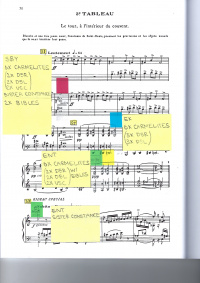Setting up a score for Opera
There are no set rules on how to prepare your score when working on an Opera, as a score is as individual as the person working with it. However, the following ideas have proven helpful:
- Post It’s are your best friends! - Information on these can easily be moved around without

having to erase it
- Place tabs by scenes or obvious breaks - Helps you (and others) to find your way through the score
- Write a key in the front of your score - This is helpful if someone else has to pick up your score
- Create a entrance and exit plot - Time/Page, System, Bar/Character/Entrance or Exit/Information (Location) - Will be used if singers have to be cued on
- Create a props and/or costume plot - Time/Page, System/Ba/Character/Costume or Prop/Further information - Helpful for costume changes and setting of props shelves
- Write timings into your score - Depending on music (complexity and tempo), but one or two-minute marks are usually good. This can be used to give an overview of how much time has passed in relation to the length of the opera as well as giving information to departments who don’t use a score for their running lists.
- Clip a bulldog clip to your score - To attach any important documents to your score.
Listen to the Opera multiple times to make yourself familiar:
for fun
for timings
for entrances and exits
for props or costume information